About Endodontics
What is endodontics?
Endodontics (root canal treatment) is necessary when the soft inner tissue, or "pulp" of the tooth becomes inflamed or infected. This may happen as a result of deep decay, repeated dental procedures on the tooth, or a blow to the tooth. Endodontic treatment removes the damaged pulp. Then the tooth's canals are cleaned and filled to help preserve the tooth.
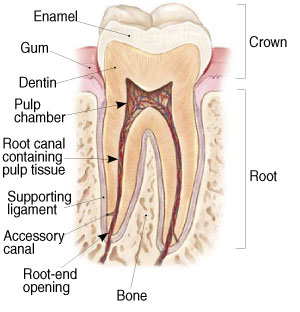
Who performs endodontic treatment?
All dentists, including your general dentist, received training in endodontic treatment in dental school. General dentists can perform endodontic procedures, but often refer patients needing endodontic treatment to endodontists. An endodontist is a dentist with special training in endodontic procedures. They provide only endodontic services in their practices because they are specialists. To become specialists, they complete dental school and an additional two or more years of advanced training in endodontics. They perform routine as well as difficult and very complex endodontic procedures, including endodontic surgery. Endodontists are also experienced at finding the cause of oral facial pain that has been difficult to diagnose.
What are the signs of needing endodontic treatment?
Signs of pulp damage include pain, prolonged sensitivity to heat or cold, discoloration of the tooth and swelling and tenderness in the nearby gums. Sometimes, however, there are no symptoms.
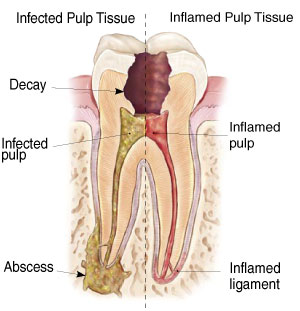
How does endodontic treatment save the tooth?
The endodontist removes the inflamed or infected pulp, carefully cleans and shapes the inside of the tooth, then fills and seals the space. Afterwards, you will return to your dentist, who will place a crown or other restoration on the tooth to protect and restore it to full function. After the restoration, the tooth continues to function like any other tooth.
Will I feel pain during or after the procedure?
Endodontic treatment is a very common procedure. With modern techniques and anesthetics most patients report that they are comfortable during the procedure.
For the first few days after treatment, your tooth may feel sensitive, especially if there was pain or infection before the procedure. This discomfort can usually be relieved with over-the-counter or prescription medications.
Your tooth may continue to feel slightly different from your other teeth for some time after your endodontic treatment is completed. However, if you have severe pain or pressure, or pain lasts more than a few days, call your endodontist.
Endodontic Procedure
Endodontic treatment can often be performed in one or two appointments and involves the following steps:
The endodontist examines and x-rays the tooth, then administers local anesthetic. After the tooth is numb the endodontist places a small protective sheet called a "dental dam" over the area to isolate the tooth and keep it clean and free of saliva during the procedure.
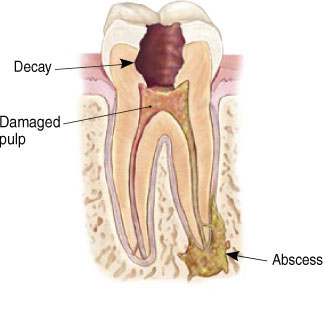
The endodontist makes an opening in the crown of the tooth. Very small instruments are used to clean the pulp from the pulp chamber and root canals, and to shape the space for filling.
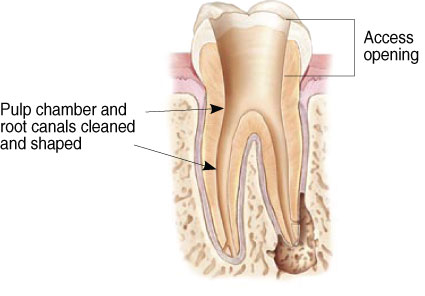
After the space is cleaned and shaped, the endodontist fills the root canals with a biocompatible material, usually a rubber-like material called "gutta percha." The gutta percha is placed with an adhesive cement to ensure complete sealing of the root canals. In most cases, a temporary filling is placed to close the opening. The temporary filling will be removed by your dentist when the tooth is restored.
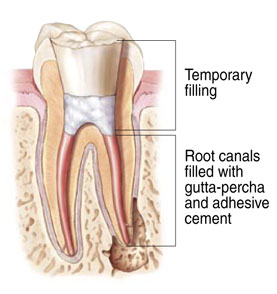
After the final visit with your endodontist, you must return to your dentist to have a crown or other restoration placed on the tooth to protect and restore it to full function.
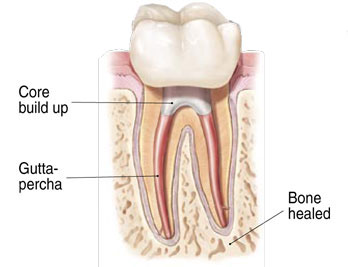
If the tooth lacks sufficient structure to hold the restoration in place, your dentist or endodontist may place a post inside the tooth. Ask your dentist or endodontist for more details about the specific restoration planned for your tooth.
How much will the procedure cost?
The cost varies depending on how severe the problem is and which tooth is affected. Molars are more difficult to treat and usually cost more. Most dental insurance policies provide coverage for endodontic treatment.
Generally, endodontic treatment and restoration of the natural tooth are less expensive than the alternative of having the tooth extracted. An extracted tooth must be replaced with a bridge or implant to restore chewing function and prevent adjacent teeth from shifting. These procedures tend to cost more than endodontic treatment and appropriate restoration.


